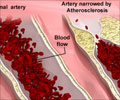
‘Low personal income and low socioeconomic status play a role in increasing the risk of cardiovascular disease.’
Tweet it Now
The study, conducted by Emory University School of Medicine, focused on the effects of income, education and socioeconomic status on healthy people living in urban food deserts in the Atlanta metropolitan area. A food desert is defined by the United States Department of Agriculture (USDA) as a location with both low access to healthy food and low income. Areas with low access to healthy foods are defined as areas where a significant share of people live a mile or more away in urban areas or 10 miles or more away in rural areas from a supermarket, supercenter or large grocery store. The USDA estimates 23.5 million people live in food deserts across the United States.
The research team analyzed data from 1,421 subjects who were recruited into two health studies: 712 from the META-Health (Morehouse and Emory Team up to Eliminate Health Disparities) study and 709 from the Predictive Health study, which recruited university employees from Emory University and the Georgia Institute of Technology.
Participants were 20 to 70-years-old with an average age of 49.4 years, 38.5 percent were male and 36.6 percent were Black.
The research team studied demographic data, metabolic profiles and early signs of cardiovascular disease, including markers for inflammation and stiffness of the arteries, an early indicator of blood vessel disease. They found that people living in food deserts (13.2 percent) had higher rates of smoking, a higher prevalence of high blood pressure and higher body mass index as well as increased arterial stiffness compared to those not living in food deserts.
Advertisement
People with high individual income who lived in low-income areas had lower cardiovascular risk and inflammation compared to people with lower individual income who lived in a similar area. Moreover, people with high individual income who lived in an area with poor food access had a better cardiovascular profile than those with lower individual income who lived in similar area.
Advertisement
According to the research team, one of the study's limitations is that it only measured risk factors and early blood vessel disease. These factors increase the risk for cardiovascular disease. In order to confirm that low income contributes to early heart disease or higher mortality from heart disease, a study with a larger number of participants with much longer follow-up needs to be conducted.
"At least in the urban environment, the definition of a food desert wasn't sufficient to explain poor health in terms of cardiovascular risk factors," said senior author Arshed A. Quyyumi, M.D., FACC, FRCP, a professor of medicine at Emory University School of Medicine and co-director of the Emory Clinical Cardiovascular Research Institute.
"This study shows that low personal income and low socioeconomic status matter when it comes to cardiovascular disease risk. Physicians need to be aware that these social determinants increase disease risk and that perhaps more attention needs to be paid to patients who fall into this category."
Source-Eurekalert















